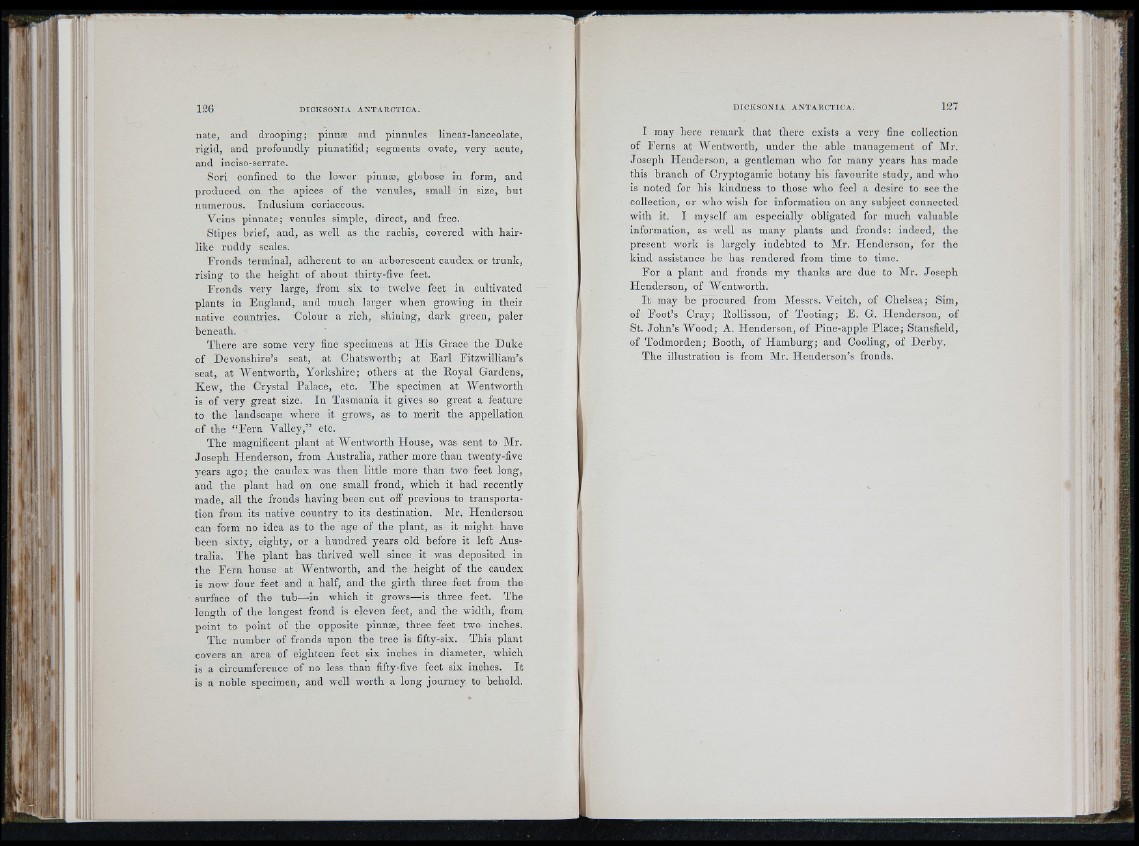
I
i I C |:
ii r
r M i
1 J . |
nate, and droo p in g ; pinnm and pinnules linear-lanceolate,
rig id , and profoundly pinnatifid; segments ovate, v ery acute,
and inciso-serrate.
Sori confined to th e lower pinna;, globose in form, and
p ro d u c ed on the apices of th e venules, small in size, b u t
numerous. In d u sium coriaceous.
Veins p in n a te ; venules simple, d ire c t, and free.
Stipes b rief, and, as well as th e rachis, covered with h a irlik
e ru d d y scales.
F ro n d s termina l, ad h e ren t to an arbore scent caudex or tru n k ,
risin g to the h e ig h t of about thirty-five feet.
F ro n d s v ery la rg e , from six to twelve feet in cultivated
plants in E n g la n d , and much la rg e r when growing iu th e ir
native countries. Colour a rich , shining, d a rk g re en , paler
beneath.
T h e re are some very fine specimens at H is Grace the D u k e
of Devo n sh ire ’s seat, at Ch a tsworth; at E a rl Eitzwilliam’s
seat, at "Wentworth, Y o rk sh ire ; others at th e Roya l Gardens,
K ew , the Crystal Pa la c e , etc. T h e specimen at W en tw o rth
is of v e ry g re a t size. I n Tasmania it gives so g re a t a feature
to the landscape w here it grows, as to me rit the appellation
o f the “ F e rn V a lle y ,” etc.
T h e magnificent p lan t at W en tw o rth Ho u se , was sent to Mr.
Jo sep h H en d e rso n , from Australia, ra th e r more th an twenty-five
years ago; th e c audex was th en little more than two feet long,
and th e p lan t had on one small frond, which it h ad recently
made, all th e fronds hav in g been cu t off previous to tran sp o rta tion
from its native country to its destination. IMr. H en d e rso n
can form no id e a as to th e age of th e p lan t, as it might have
been sixty, e ighty, or a h u n d re d y ears old before it left A u stralia
. T h e p lan t has th riv e d well since it was deposited in
th e F e rn house at W en tw o rth , and th e h e ig h t of the caudex
is now four feet and a half, and th e g ir th th re e feet from th e
surface o f th e tu b—in which it grows—is th re e feet. T h e
len g th of the longest fro n d is eleven feet, and the w id th , from
p o in t to p oint of the opposite piunse, th re e feet two inches.
T h e n umber of fronds upon th e tree is fifty-six. T h is p lan t
covers an area of eighteen feet six inches in diameter, which
is a circumference of no less th an fifty-five feet six inches. I t
is a noble specimen, and well wo rth a long jo u rn e y to behold.
I may he re remark th a t th e re exists a ve ry fine collection
of F e rn s at Wen two rth , u n d e r the able management o f Mr.
Jo sep h H en d e rso n , a gentleman who for many years has made
this bran ch of Cryptogamic botany his favourite stu d y , and who
is no ted for his kindness to those who feel a desire to see the
collection, or who wish for information on any subje ct connected
with it. I myself am especially obligated for much valuable
information, as well as many plants and fronds: ind e ed , the
p re sen t work is larg e ly in d eb ted to Mr. H en d e rso n , for the
k in d assistance he has ren d e red from time to time.
F o r a p lan t and fronds my thanks are due to Mr. Jo sep h
H en d e rso n , of Wen two rth .
I t may be p ro cu red from Messrs. Ve itch , of C he lsea; Sim,
of F o o t’s Cray ; Rollisson, of T oo tin g ; E . G. H en d e rso n , of
St. J o h n ’s W o o d ; A. H en d e rso n , of P in e -ap p le P la c e ; Stansfield,
of T o dmorden; Booth, of H am b u rg ; and Cooling, of Derbjn
T h e illustration is from Mr. H en d e rso n ’s fronds.